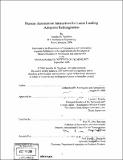Human-automation interaction for lunar landing aimpoint redesignation
Author(s)
Needham, Jennifer M
DownloadFull printable version (25.82Mb)
Other Contributors
Massachusetts Institute of Technology. Dept. of Aeronautics and Astronautics.
Advisor
Lauren J. Kessler and R. John Hansman.
Terms of use
Metadata
Show full item recordAbstract
Human-automation interactions are a critical area of research in systems with modem automation. The decision-making portion of tasks presents a special challenge for human-automation interactions because of the many factors that play a role in the decision-making process. This is prominent in human spaceflight, where the astronaut must continually interact with the vehicle systems. In future lunar landings, astronauts working in conjunction with automated systems will need to select a safe and achievable landing aimpoint. Ultimately, this decision could risk the safety of the astronauts and the success of their mission. Careful study is needed to ascertain the roles of both the human and the automation and how design can best support the decision making process. The task of landing on the moon was first achieved by the Apollo program in 1969, but technological advances will provide future landings with a greater variety and extensibility of mission goals. The modem task of selecting a landing aimpoint is known as landing point redesignation (LPR), and this work capitalizes on an existing LPR algorithm in order to explore the effects on landing point selection by altering the levels of automation. An experiment was designed to study the decision-making process with three different levels of automation. In addition, the effect of including a human-generated goal that was not captured by the automation was studied. The experimental results showed that the subjects generally used the same decision strategies across the different levels of automation, and that higher levels of automation were able to eliminate earlier parts of the decision strategy and allow the subjects to select a landing aimpoint more quickly. In scenarios with the additional human goal, subjects tended to sacrifice significant safety margins in order to achieve proximity to the point of interest. Higher levels of automation allowed them to maintain high levels of safety margins in addition to achieving their external goal. Thus, it is concluded that with a display design supporting human goals in a decision-making task, automated decision aids that make recommendations and assist communication of the automation's processes are highly beneficial.
Description
Thesis (S.M.)--Massachusetts Institute of Technology, Dept. of Aeronautics and Astronautics, 2008. Includes bibliographical references (leaves 86-89).
Date issued
2008Department
Massachusetts Institute of Technology. Department of Aeronautics and AstronauticsPublisher
Massachusetts Institute of Technology
Keywords
Aeronautics and Astronautics.